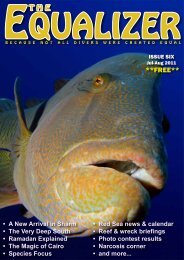Field Guide to Seagrasses of the Red Sea - Seagrass-Watch
Field Guide to Seagrasses of the Red Sea - Seagrass-Watch
Field Guide to Seagrasses of the Red Sea - Seagrass-Watch
You also want an ePaper? Increase the reach of your titles
YUMPU automatically turns print PDFs into web optimized ePapers that Google loves.
Halodule pinifolia<br />
(Miki) den Har<strong>to</strong>g<br />
Halodule pinifolia (Plate 1) is known from <strong>the</strong> sou<strong>the</strong>rn Egyptian coast (El<br />
Shaffai, 2011), but is probably more widespread in suitable habitat. As Halodule<br />
pinifolia is morphologically very similar <strong>to</strong> Halodule uninervis, it has probably<br />
been reported as <strong>the</strong> latter in many places. It is not always easy <strong>to</strong> differentiate<br />
between <strong>the</strong> two species. Indeed Waycott, et al., (2004) reported that Halodule<br />
pinifolia is genetically identical <strong>to</strong> Halodule uninervis.<br />
Morphology<br />
Leaf<br />
The leaf blade is less than 20 cm long and 0.02-0.1 cm wide, linear and flat.<br />
The leaf sheath is well developed and <strong>the</strong>re are three longitudinal leaf veins.<br />
Leaf margin is mostly smooth but finely serrated at <strong>the</strong> tip. The most distinctive<br />
feature is <strong>the</strong> black central vein at <strong>the</strong> leaf tip, which splits in<strong>to</strong> two at <strong>the</strong><br />
apex.<br />
Stem<br />
The stem <strong>of</strong> this species is short, erect, vertical and bearing 1-2 leaves. It is<br />
<strong>Field</strong> <strong>Guide</strong> <strong>to</strong> <strong><strong>Sea</strong>grasses</strong> <strong>of</strong> <strong>the</strong> <strong>Red</strong> <strong>Sea</strong> 19





